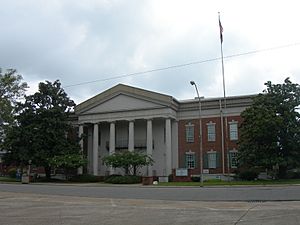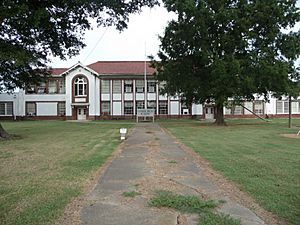Sunflower County, Mississippi facts for kids
Quick facts for kids
Sunflower County
|
|
|---|---|

Sunflower County Courthouse
|
|

Location within the U.S. state of Mississippi
|
|
 Mississippi's location within the U.S. |
|
| Country | |
| State | |
| Founded | 1844 |
| Named for | Sunflower River |
| Seat | Indianola |
| Largest city | Indianola |
| Area | |
| • Total | 707 sq mi (1,830 km2) |
| • Land | 698 sq mi (1,810 km2) |
| • Water | 9.2 sq mi (24 km2) 1.3% |
| Population
(2020)
|
|
| • Total | 25,971 |
| • Density | 36.734/sq mi (14.183/km2) |
| Time zone | UTC−6 (Central) |
| • Summer (DST) | UTC−5 (CDT) |
| Congressional district | 2nd |
Sunflower County is a place in the state of Mississippi, USA. It is known for its rich history and flat lands. In 2020, about 25,971 people lived here.
The biggest city and main government center is Indianola. Sunflower County is part of the Mississippi Delta region. This area is famous for its farming and music history. The Mississippi State Penitentiary, also called Parchman Farm, is also located here.
Contents
- A Look Back: History of Sunflower County
- Where is Sunflower County? Geography Facts
- Who Lives Here? Population Changes
- Economy: How People Make a Living
- Getting Around: Transportation in Sunflower County
- Learning and Growing: Education in Sunflower County
- News and Information: Media in Sunflower County
- Places to Live: Communities in Sunflower County
- Famous Faces: Notable People from Sunflower County
- See also
A Look Back: History of Sunflower County
Sunflower County was created in 1844. At first, it covered a much larger area. The first county seat, or main town for government, was Clayton. Later, it moved to McNutt.
In 1871, Sunflower County became its own separate area. The new county seat was Johnsonville. Then, in 1882, it moved to Eureka, which is now called Indianola. An old burial ground, Boyer Cemetery, shows how long people have lived in this area.
After the U.S. Civil War, many African Americans moved to Sunflower County. They came to work on farms in the Mississippi Delta. In 1870, about 3,243 Black people lived here. By 1900, this number grew to 12,070. This meant they made up 75% of the people in the county. Their population nearly tripled between 1900 and 1920.
Where is Sunflower County? Geography Facts
Sunflower County is a large area, covering about 707 square miles. Most of this is land (698 square miles). Only a small part (1.3%) is water. It is the longest county in Mississippi. Traveling from its south end to its north end is about 71 miles.
The county is about 30 miles east of the Mississippi River. It is also about 100 miles north of Jackson. And it's about 100 miles south of Memphis, Tennessee.
Neighboring Counties
- Coahoma County (north)
- Tallahatchie County (northeast)
- Leflore County (east)
- Humphreys County (south)
- Washington County (southwest)
- Bolivar County (northwest)
Who Lives Here? Population Changes
| Historical population | |||
|---|---|---|---|
| Census | Pop. | %± | |
| 1850 | 1,102 | — | |
| 1860 | 5,019 | 355.4% | |
| 1870 | 5,015 | −0.1% | |
| 1880 | 4,661 | −7.1% | |
| 1890 | 9,384 | 101.3% | |
| 1900 | 16,084 | 71.4% | |
| 1910 | 28,787 | 79.0% | |
| 1920 | 46,374 | 61.1% | |
| 1930 | 66,364 | 43.1% | |
| 1940 | 61,007 | −8.1% | |
| 1950 | 56,031 | −8.2% | |
| 1960 | 45,750 | −18.3% | |
| 1970 | 37,047 | −19.0% | |
| 1980 | 34,844 | −5.9% | |
| 1990 | 32,867 | −5.7% | |
| 2000 | 34,369 | 4.6% | |
| 2010 | 29,450 | −14.3% | |
| 2020 | 25,971 | −11.8% | |
| 2023 (est.) | 24,468 | −16.9% | |
| U.S. Decennial Census 1790-1960 1900-1990 1990-2000 2010-2013 |
|||
The number of people living in Sunflower County was highest in 1930. After that, the population went down until 1990. Many people moved away from the county. This happened because new machines meant fewer farm jobs. Both white and Black people left the county. Many African Americans moved north or west. They sought jobs in cities and wanted to escape unfair treatment. This big move is called the Great Migration.
2020 Census: A Snapshot of Sunflower County Residents
| Race | Num. | Perc. |
|---|---|---|
| White | 6,729 | 25.91% |
| Black or African American | 18,077 | 69.6% |
| Native American | 19 | 0.07% |
| Asian | 84 | 0.32% |
| Pacific Islander | 3 | 0.01% |
| Other/Mixed | 401 | 1.54% |
| Hispanic or Latino | 661 | 2.55% |
In 2020, there were 25,971 people living in Sunflower County. There were 8,322 households, which are groups of people living together.
2010 Census: A Look Back
In 2010, there were 29,450 people in the county. About 72.9% were Black or African American. About 25.4% were white. Other groups made up smaller parts of the population. About 1.4% of people were Hispanic or Latino.
Economy: How People Make a Living
In December 2011, the unemployment rate in Sunflower County was 16.2%. This was higher than the state and national rates. As of 2012, Sunflower County was considered one of the poorer counties in the United States.
Getting Around: Transportation in Sunflower County
Main Roads
Airports
There are two airports in Sunflower County. The Indianola Municipal Airport is near Indianola. The Ruleville-Drew Airport is between Drew and Ruleville. Both are used for local flights.
Learning and Growing: Education in Sunflower County
Colleges and Universities
Mississippi Delta Community College has its main campus in Moorhead. It also has other locations for students.
Schools for Kids
Public Schools
- Public School Districts
- Sunflower County Consolidated School District is the only school district in the county.
- Before, there were three separate districts: Drew School District, Indianola School District, and Sunflower County School District.
Between 2010 and 2012, the state of Mississippi took over these three school districts. This happened because of problems with school performance and money. In 2012, a new law was passed. It combined all three districts into one big district. This new district serves the entire county.
Private Schools
- Private Schools
- Indianola Academy (in Indianola)
- North Sunflower Academy (in an area not part of a city)
- Restoration Ministries Christian Academy
Some of these private schools, like Indianola Academy and North Sunflower, started as "segregation academies." These were schools created during a time when schools were separated by race. Central Delta Academy in Inverness closed in 2010. Some students from Sunflower County also go to Pillow Academy in a nearby county.
Public Libraries
The Sunflower County Library offers books and services to everyone. The main office is in Indianola. There are also libraries in Drew, Indianola, Inverness, Moorhead, and Ruleville.
News and Information: Media in Sunflower County
The Enterprise-Tocsin is a local newspaper from Indianola. It is delivered throughout Sunflower County. Another newspaper, The Bolivar Commercial, is also available here.
Places to Live: Communities in Sunflower County
Sunflower County has always been mostly rural, meaning it has more countryside than big cities. At the end of the 1900s, it had only four main towns.
Cities
Towns
Smaller Communities (Unincorporated)
Old Towns (Ghost Towns)
Famous Faces: Notable People from Sunflower County
- Jerry Butler (singer and Rock and Roll Hall of Fame member)
- Willie Best (actor)
- Craig Claiborne (New York Times food editor)
- James Eastland (U.S. Senator)
- C. L. Franklin, father of Aretha Franklin (minister, civil rights activist)
- Fannie Lou Hamer (civil rights activist)
- B.B. King (famous blues musician)
- Sam Lacey (retired NBA basketball player)
- Archie Manning (NFL quarterback)
- Charlie Patton (blues musician)
- Johnny Russell (country singer)
See also
 In Spanish: Condado de Sunflower (Misisipi) para niños
In Spanish: Condado de Sunflower (Misisipi) para niños



